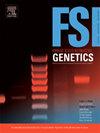Nanopore sequencing of MiniHap biomarkers for forensic DNA mixture deconvolution: A proof-of-principle study
IF 3.1
2区 医学
Q2 GENETICS & HEREDITY
引用次数: 0
Abstract
Mixture deconvolution remains one of the major challenges in the field of forensic science. Currently, genetic markers are used and studied in the field of forensic genetics, including short tandem repeat (STR), insertion/deletion polymorphism (InDel), single nucleotide polymorphism (SNP), InDel closely linked to STR (DIP-STR), SNP closely linked to STR (SNP-STR), InDel closely linked to SNP (DIP-SNP) and microhaplotype (MH), all of which have been studied for DNA mixture analysis and have their own advantages and disadvantages. Mini-haplotype (MiniHap), as a novel haplotype genetic marker, contains 5 or more SNPs. A previous study has substantiated its significant high polymorphic characteristics, and it is expected to have potential applications in individual identification, paternity testing, ancestry inference, and mixture deconvolution. In this study, we first screened 22 MiniHaps with high polymorphism potential and constructed a panel based on the QNome nanopore sequencing device. Subsequently, we tested 100 unrelated Chinese Han individuals to evaluate the sequencing performance, allele (haplotype) frequencies, effective number of alleles (Ae) and forensic parameters of the 22 MiniHaps markers included in this novel assay. Next, a series of mixture simulations (two- or three-person mixtures with mixing ratios of 1:1–1:99 or 1:1:1–1:8:1) based on three standard materials (9947 A, 9948 and 2800 M) were detected by this MiniHap panel to explore its potential for DNA mixture deconvolution. The average Ae value was 10.9574, and 52.38 % of MiniHap loci had Ae values greater than 12.0000. The mean values of genetic diversity (GD) and power of discrimination (PD) were 0.8717 and 0.9457, respectively. Notably, most MiniHaps (85.71 %) had PD values exceeding 0.9000. The combined match probability (CMP) and combined power of exclusion (CPE) of this MiniHap panel were 4.4505 × 10−31 and 0.999999999999999996653, respectively. Moreover, the results of mixture analysis demonstrated that this MiniHap panel allowed detecting the components of minor contributor (s) even in imbalanced mixture samples, with detection limits of 1:39 and 1:8:1 for two- and three-person mixtures, respectively. In summary, MiniHap markers have remarkable application potential in mixture deconvolution, and it is necessary to conduct in-depth research on MiniHap markers for mixture analysis in the future.
用于法医DNA混合物反褶积的MiniHap生物标志物的纳米孔测序:一项原理证明研究
混合反褶积仍然是法医学领域的主要挑战之一。目前,在法医遗传学领域使用和研究的遗传标记包括短串联重复序列(STR)、插入/删除多态性(InDel)、单核苷酸多态性(SNP)、与STR紧密相连的InDel (DIP-STR)、与STR紧密相连的SNP (SNP-STR)、与SNP紧密相连的InDel (DIP-SNP)和微单倍型(MH),这些标记都被研究用于DNA混合分析,各有优缺点。Mini-haplotype (MiniHap)是一种新型的单倍型遗传标记,包含5个或更多的snp。先前的研究已经证实了其显著的高多态性特征,并有望在个体鉴定,亲子鉴定,祖先推断和混合反褶积方面具有潜在的应用。在这项研究中,我们首先筛选了22个具有高多态性潜力的MiniHaps,并基于QNome纳米孔测序装置构建了一个面板。随后,我们对100名无亲缘关系的中国汉族个体进行了测试,以评估该新方法中包含的22种MiniHaps标记的测序性能、等位基因(单倍型)频率、有效等位基因数(Ae)和法医学参数。接下来,基于三种标准材料(9947 a, 9948和2800 M), MiniHap面板检测了一系列混合模拟(混合比例为1:1-1:99或1:1:1-1:8:1的两人或三人混合物),以探索其DNA混合物反卷积的潜力。平均Ae值为10.9574,52.38 %的MiniHap位点Ae值大于1.2万。遗传多样性(GD)均值为0.8717,辨别力(PD)均值为0.9457。值得注意的是,大多数MiniHaps(85.71 %)的PD值超过0.9000。该MiniHap面板的组合匹配概率(CMP)和组合排除能力(CPE)分别为4.4505 × 10−31和0.9999999999999996653。此外,混合物分析结果表明,即使在不平衡的混合物样品中,该MiniHap面板也可以检测到次要贡献者的成分,对两人和三人混合物的检测限分别为1:39和1:8:1。综上所述,MiniHap标记物在混合反褶积中具有显著的应用潜力,未来有必要对MiniHap标记物进行深入研究,用于混合分析。
本文章由计算机程序翻译,如有差异,请以英文原文为准。
求助全文
约1分钟内获得全文
求助全文
来源期刊
CiteScore
7.50
自引率
32.30%
发文量
132
审稿时长
11.3 weeks
期刊介绍:
Forensic Science International: Genetics is the premier journal in the field of Forensic Genetics. This branch of Forensic Science can be defined as the application of genetics to human and non-human material (in the sense of a science with the purpose of studying inherited characteristics for the analysis of inter- and intra-specific variations in populations) for the resolution of legal conflicts.
The scope of the journal includes:
Forensic applications of human polymorphism.
Testing of paternity and other family relationships, immigration cases, typing of biological stains and tissues from criminal casework, identification of human remains by DNA testing methodologies.
Description of human polymorphisms of forensic interest, with special interest in DNA polymorphisms.
Autosomal DNA polymorphisms, mini- and microsatellites (or short tandem repeats, STRs), single nucleotide polymorphisms (SNPs), X and Y chromosome polymorphisms, mtDNA polymorphisms, and any other type of DNA variation with potential forensic applications.
Non-human DNA polymorphisms for crime scene investigation.
Population genetics of human polymorphisms of forensic interest.
Population data, especially from DNA polymorphisms of interest for the solution of forensic problems.
DNA typing methodologies and strategies.
Biostatistical methods in forensic genetics.
Evaluation of DNA evidence in forensic problems (such as paternity or immigration cases, criminal casework, identification), classical and new statistical approaches.
Standards in forensic genetics.
Recommendations of regulatory bodies concerning methods, markers, interpretation or strategies or proposals for procedural or technical standards.
Quality control.
Quality control and quality assurance strategies, proficiency testing for DNA typing methodologies.
Criminal DNA databases.
Technical, legal and statistical issues.
General ethical and legal issues related to forensic genetics.

 求助内容:
求助内容: 应助结果提醒方式:
应助结果提醒方式:


